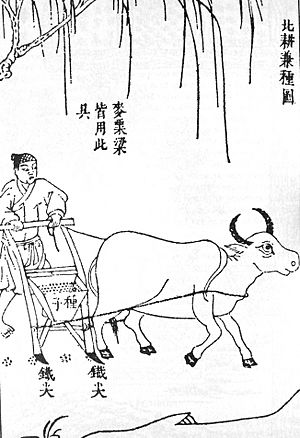Seed drill facts for kids
A seed drill is a sowing device that sows the seed precisely in the soil at proper depth and distance. Then it covers them with soil. It protects the seeds from birds and saves time and labour.
With seed drill machines, seeds are distributed in rows; this allows plants to get sufficient sunlight, nutrients, and water from the soil.
Contents
History

While the Babylonians used primitive seed drills around 1400 BCE, the invention never reached Europe. Multi-tube iron seed drills were invented by the Chinese in the 2nd century BCE. This multi-tube seed drill has been credited with giving China an efficient food production system that allowed it to support its large population for millennia. This multi-tube seed drill may have been introduced into Europe following contacts with China. In the Indian subcontinent, the seed drill was in widespread use among peasants by the time of the Mughal Empire in the 16th century.
The first known European seed drill was attributed to Camillo Torello and patented by the Venetian Senate in 1566. A seed drill was described in detail by Tadeo Cavalina of Bologna in 1602. In England, the seed drill was further refined by Jethro Tull in 1701 in the Agricultural Revolution. However, seed drills of this and successive types were both expensive and unreliable, as well as fragile. Seed drills would not come into widespread use in Europe until the mid to late 19th century, when manufacturing advances such as machine tools, die forging and metal stamping allowed large scale precision manufacturing of metal parts.
Early drills were small enough to be pulled by a single horse, and many of these remained in use into the 1930s. The availability of steam, and later gasoline tractors, however, saw the development of larger and more efficient drills that allowed farmers to seed ever larger tracts in a single day.
Recent improvements to drills allow seed-drilling without prior tilling. This means that soils subject to erosion or moisture loss are protected until the seed germinates and grows enough to keep the soil in place. This also helps prevent soil loss by avoiding erosion after tilling. The development of the press drill was one of the major innovations in pre-1900 farming technology.
Seed-counting machines can be an integral part of a seed drill.
Impact
The invention of the seed drill dramatically improved farming.
This innovation permitted farmers to have precise control over the depth at which seeds were planted. Seeds were able to take optimum advantage of available soil moisture in a prepared seedbed. The result was that farmers were able to use less seed and at the same time experience larger yields.
The use of a seed drill also facilitates weed control. A field planted using a seed drill is much more uniform, typically in rows, allowing weeding with a hoe during the growing season. Weeding by hand is laborious and inefficient. Poor weeding reduces crop yield, so this benefit is extremely significant.
Images for kids
See also
 In Spanish: Sembradora para niños
In Spanish: Sembradora para niños






